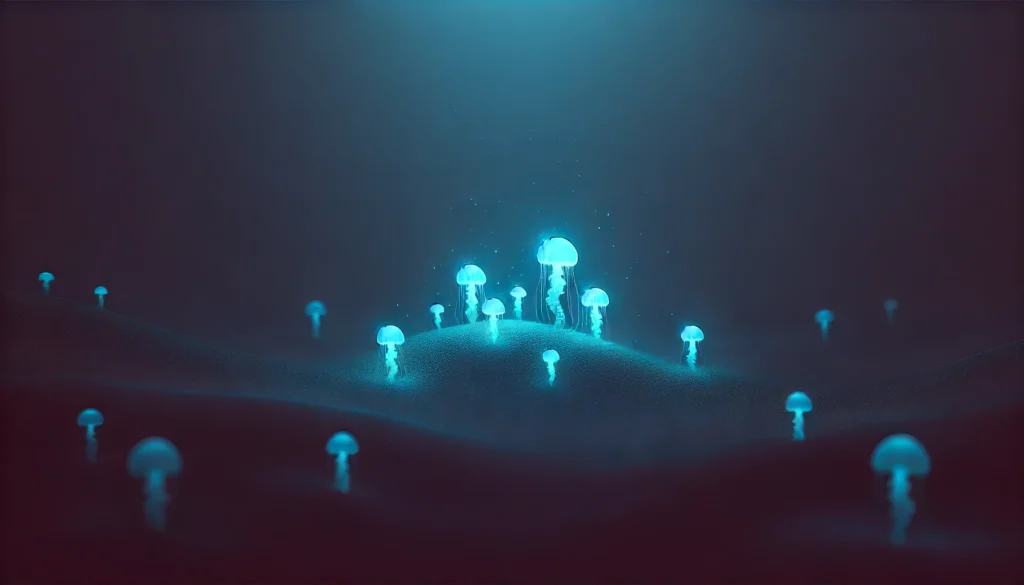Have you ever seen fireflies flickering on a warm summer night, or watched a nature documentary showcasing the eerie glow of deep-sea creatures? That’s bioluminescence – nature’s very own light show, powered by chemical reactions. It’s a phenomenon that’s both beautiful and scientifically intriguing, present in a wide range of organisms across our planet.
What is Bioluminescence?
Bioluminescence is the production and emission of light by a living organism. It’s a form of chemiluminescence, meaning light is produced through a chemical reaction. This reaction typically involves a light-emitting molecule called luciferin and an enzyme called luciferase.
Here’s a simplified breakdown:
- Luciferin meets Luciferase: Luciferin combines with oxygen in the presence of luciferase.
- Energy Release: This triggers a chemical reaction that releases energy in the form of light.
- The Glow: The color of the light depends on the specific luciferin and luciferase involved, ranging from blue and green to yellow and red.
Where Can You Find Bioluminescence?
Bioluminescence is more common than you might think! Here are some examples:
- Fireflies (Lightning Bugs): These familiar insects use bioluminescence for communication, primarily for attracting mates.
- Deep-Sea Creatures: Many deep-sea animals, like anglerfish and certain jellyfish, use bioluminescence for hunting, defense, and communication in the dark depths.
- Dinoflagellates: These microscopic marine plankton create dazzling displays of light when disturbed, causing “bioluminescent bays” that glow at night.
- Fungi: Some species of mushrooms, like the “foxfire” fungus, emit a faint green glow, potentially to attract insects for spore dispersal.
- Bacteria: Certain bacteria living in symbiotic relationships with other organisms, like the Hawaiian bobtail squid, use bioluminescence for camouflage.
Why Do Organisms Use Bioluminescence?
Bioluminescence serves various purposes, depending on the organism:
- Attracting Prey: Anglerfish use a glowing lure to attract unsuspecting prey in the darkness.
- Defense: Some squid release a cloud of bioluminescent fluid to confuse predators, allowing them to escape.
- Communication: Fireflies use their flashes to signal to potential mates.
- Camouflage: Some deep-sea creatures use counter-illumination, matching the faint light from above to blend in with their surroundings.
- Attracting Pollinators/Spore Dispersers: Some fungi may use light to attract insects that help spread spores.
The Science Behind the Glow:
Scientists are still uncovering the intricacies of bioluminescence. Research focuses on:
- Understanding the specific chemical reactions involved.
- Identifying new luciferin and luciferase molecules.
- Exploring the evolutionary origins of bioluminescence.
- Developing applications for bioluminescence in fields like medical imaging and environmental monitoring.
Applications of Bioluminescence:
Bioluminescence has found practical applications in various fields:
- Medical Research: Luciferase is used as a reporter gene in genetic engineering to track gene expression.
- Environmental Monitoring: Bioluminescent bacteria can be used to detect pollutants in water and soil.
- Forensic Science: Bioluminescent markers can be used to visualize biological evidence.
See also The Future of Work: How Remote Work Is Reshaping Careers and Companies
Conclusion:
Bioluminescence is a testament to the incredible diversity and ingenuity of life on Earth. From the twinkling lights of fireflies to the eerie glow of deep-sea creatures, this natural phenomenon continues to fascinate and inspire us. As our understanding of bioluminescence grows, we can unlock its potential for various scientific and technological advancements.
Outbound Links:
- National Geographic: Bioluminescence – https://www.nationalgeographic.com/science/article/bioluminescence
- NOAA Ocean Exploration: What is Bioluminescence? – https://oceanexplorer.noaa.gov/facts/bioluminescence.html
- Scientific American: How Bioluminescence Works – https://www.scientificamerican.com/article/how-bioluminescence-works/
- Wikipedia: Bioluminescence – https://en.wikipedia.org/wiki/Bioluminescence



